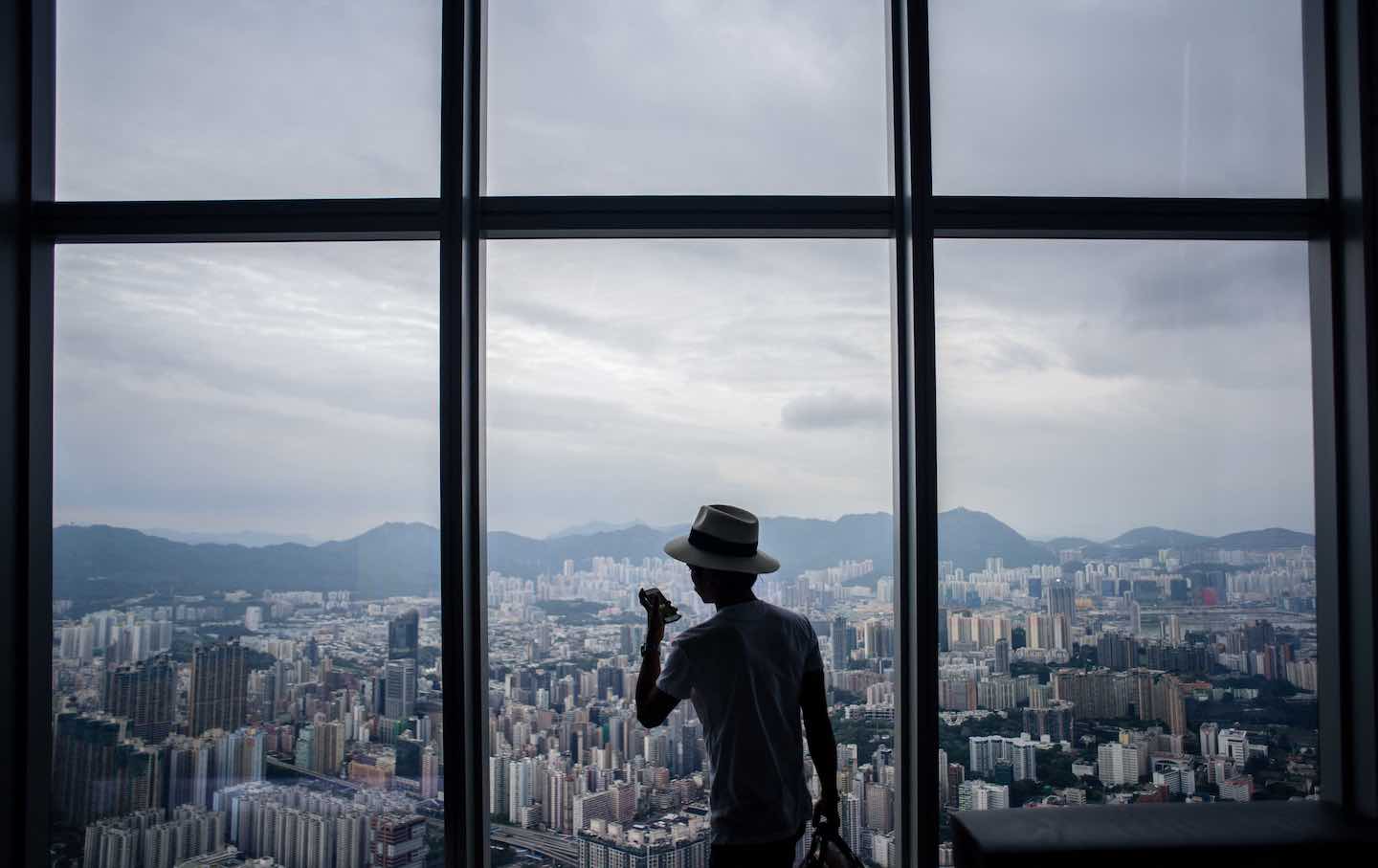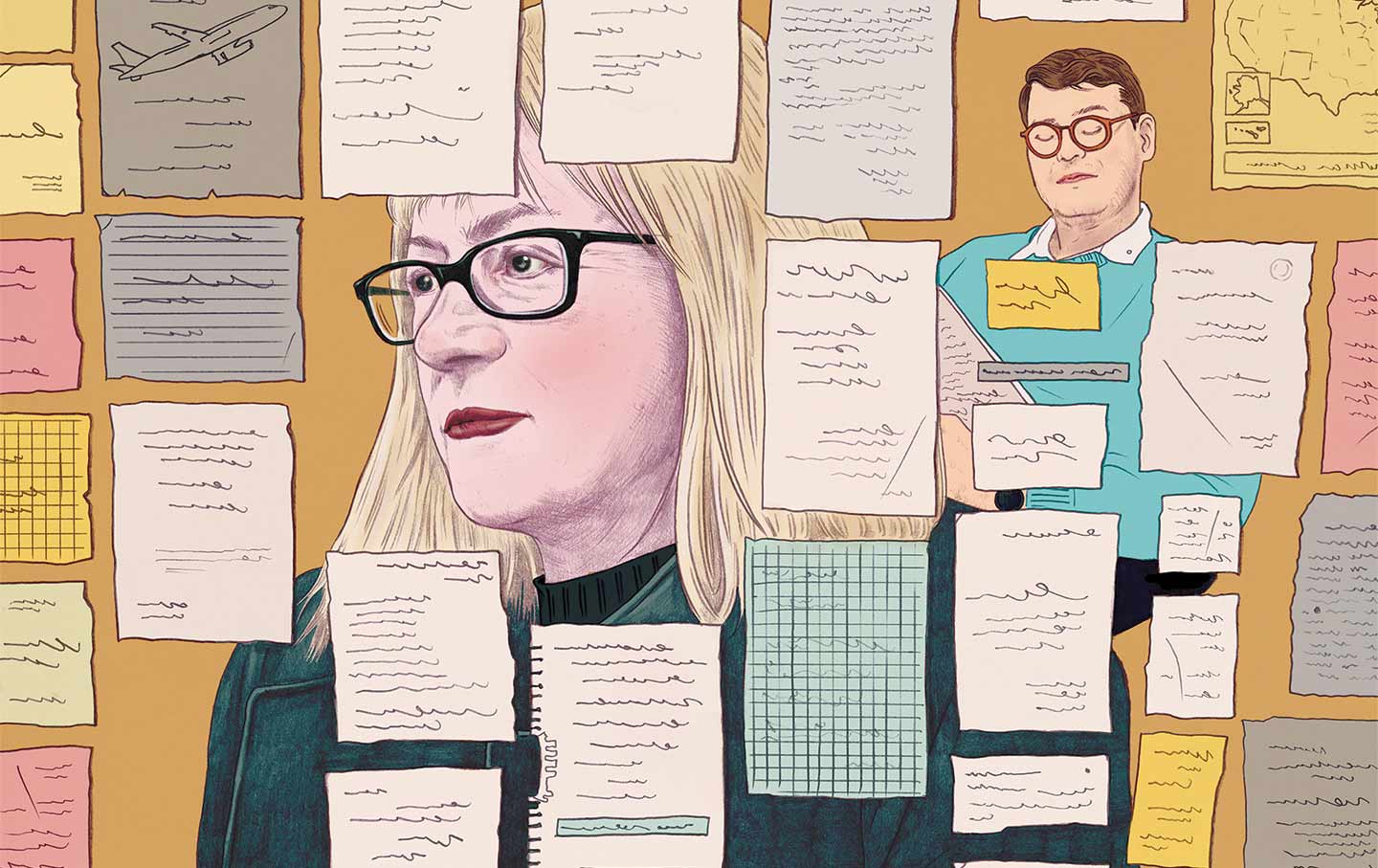
The rich have always sought loopholes. But today’s ultra-wealthy have invented new ways to bypass the bonds of democratic government and oversight altogether. This is the topic of historian Quinn Slobodian’s new book, Crack-Up Capitalism. It brings to light a series of neoliberal and libertarian-inspired attempts to “crack up” the traditional responsibilities of state governments through the establishment of various kinds of “zones,” such as free ports, tax havens, and special economic spaces, allowing market competition to be excluded from accountability. Slobodian’s exploration of these zones takes readers on a journey from Hong Kong and Singapore to South Africa and Silicon Valley as he demonstrates how radical libertarians, from Milton Friedman to Peter Thiel, Curtis Jarvin to Balaji Srinivasan, tried to create the conditions for a capitalist utopia. I spoke with Slobodian about his notion of crack-up capitalism, why spaces in the Global South have been so attractive to the cast of libertarian characters he has assembled, the racist implications of their ideas, and how the United States has become a laboratory for the formation of such zones.
—Daniel Steinmetz-Jenkins
DSJ: Let’s start with what you mean by “crack-up capitalism.” What are its essential features? And in what sense does it contradict the picture that we have about the end of the Cold War, namely a new era of liberal internationalism, globalization, interconnection, etc.?
QS: My intention with the category of crack-up capitalism was to work against some of the dominant storylines we have about the history of the last 30 years. Especially since 2016, a certain commonsense orthodoxy has hardened about the period since the end of the Cold War as one of scaling upwards. It was a time of multilateral trade agreements, supranational organizations, ocean-spanning supply chains, and ever denser communication networks. The master image is that of a globe crisscrossed with laser-like vectors of exchange. With Crack-Up Capitalism, I wanted to remind readers first of the ways that the recent past was a time of fragmentation, characterized by the breakup of large polities, the emergence of new transnational actors operating in spaces between the domains of public and private, and, as geographers and anthropologists have reminded us for decades, the proliferation of zones that exist beneath the envelope of the nation-state, with bespoke sets of laws and regulations designed to attract mobile capital.
Beyond the descriptive function, I use the concept to describe an ideology at the more radical end of neoliberal thought. I had spent some years insisting that the state never goes away in neoliberalism, but I thought it was time to reckon with the fact that thinkers in the so-called anarcho-capitalist vein did, in fact, envision the possibility of a world without states, when all traditional responsibilities of governments would be taken over by private service providers and contractors. These thinkers pine for the crack-up: They want to accelerate the breakdown of existing political systems to build something new in the wreckage where they have the advantage, and where the political inheritances of the modern age—including mass democracy, social justice, national self-determination, and the social state—will be sloughed off and left behind like a discarded skin from which a host of private micro-polities clad in sleek exoskeletons could emerge.
DSJ: Is Crack-Up Capitalism essentially one way of telling the story of neoliberalism’s history from the 1990s until the present, or does the term constitute a break from the core tenets of neoliberal thought?
QS: One of the things that I have pushed, along with collaborators, is a narrower definition of “neoliberalism” that applies, for the most part, only to a discrete intellectual tradition connected to the debates among members of the Mont Pelerin Society, a private club founded by Friedrich Hayek in 1947 and a site of robust discussion since then. Paradoxically, narrowing the definition in this way does not produce a simpler set of ideological precepts. In fact, even within this group of people engaged with the core question for the last 70 years of how to protect capitalism from democracy, there is a great range of points of emphasis.
The Virginia School inspired by James M. Buchanan focused on constitutional design and legal questions. The Chicago School is more concerned with microeconomic foundations. The Austrian School has a more subjectivist and almost sociological understanding of value. What I have called the Geneva School is primarily concerned with matters of international economic order. No school wears the neoliberal crown alone, and engaging in pars pro toto arguments about which is the real neoliberalism is a mug’s game. Rather, what is worthwhile is to investigate how different strands of thought influenced policymaking circles at different moments, whether it is ordoliberalism in Germany or the emphasis on property rights inspired by Ronald Coase and Hernando de Soto in international development circles.
In the big tent of neoliberal thought, there has always been a small table occupied by those radical libertarians who believe not just in a small state but in no state at all. I found it odd that so little attention has been given to this group, especially because, in the last half-decade, anarcho-capitalism has had a major presence in the new, often online political formations that have helped build support and some degree of intellectual heft for far-right politics, from Bolsonarismo in Brazil to the Alternative für Deutschland party in Germany to the alt-right in the US and, more recently, Konfederacja in Poland and Javier Milei in Argentina. While “ancaps” and their close relatives, the “goldbugs”—or people who believe that we need to eliminate fiat currency and return to a currency fully backed by a shiny yellow metal—have had their own ecosystem of investment newsletters, conferences, and websites for decades, the global financial crisis, the eurozone crisis, and perhaps most importantly, the emergence of cryptocurrency have all given new energy to the ideology.
As morbid symptoms of the age of zero-interest-rate policy, ancaps and goldbugs have become a kind of radical internal opposition to the more technocratic version of neoliberalism associated with the rule of central bankers and counter-majoritarian institutions. In that sense, they are both of the neoliberal movement and against it. One of the impressive qualities of the neoliberal intellectual tradition is how it has more or less maintained its coherence despite often significant internal differences of opinion over the management of money, migration, the utility of populism, and other divisive issues. The open rebellion of some factions within the big tent is a reversion to the more familiar sectarian tendency of intellectual movements, and it shows why it is not enough to think of neoliberalism as the house ideology of capitalism as such.
DSJ: It seems most of the zones for crack-up capitalism that your book covers are in the Global South and China. Indeed, the intriguing early chapters explain how neoliberals viewed Hong Kong and Singapore as the very embodiment of their capitalist antidemocratic fantasies. The book also discusses South Africa, Somalia, and Dubai. Is the story you tell here that of the continuation of imperialism under a neoliberal guise?
QS: The more time goes on, the more I wonder whether it’s helpful to think about empire and imperialism as if these are coherent, internally bound categories that can be seen to have a beginning and an end. The range in variety of the practices of statecraft in the 19th century alone is so heterogeneous that it almost seems reckless to give it one label. Likewise, the supposed promise of national autonomy that came with independence for the former imperial colonies was so patently filled with exceptions and constraints that to contrast it starkly with what preceded it is almost analytically misleading. At the risk of losing our tidy periodization, we might be better off thinking about the repertoire of practices that were used in the so-called Age of Empire and in the period after decolonization. When one adopts the minimal definition of “empire” used by my teachers Jane Burbank and Fred Cooper—as polities that “rule different populations differently”—one immediately sees the continuity with the present.
One could think about the creation of enclaves and other heterogeneous legal spaces, the “unequal integration” (as Adom Getachew puts it) of independent nations into international organizations, the persistence and proliferation of supranational institutions and forums, the recognition of self-government for Indigenous communities, and so on, as forms of oversight and governance that are empire-like without bringing with them the epochal moral charge of imperial rule. In the end, the line is simply too blurred between empire and what followed to hang too much of our interpretation on it. Rather than being surprised by moments where autonomy is overruled by external factors, we should be surprised by those moments where there are opportunities for genuine self-determination. Empire is everywhere—it is non-empire that is hard to find.
The fact that the crown colony of Hong Kong became a beacon of hope for neoliberals in the late 1970s tells us something about how the formal practices of empire were transformed into those of late-20th-century capitalism. The surprising fact that seemingly archaic or anarchistic sites like Dubai or civil-war-era Somalia were nonetheless relatively high-performing in economic terms reveals something about the fallacy or weakness of an overly rigid timeline of state development that still informs much of our teaching and scholarship as historians. Looked at through the lens of crack-up capitalism, one sees that the timeline of modernization is more like a loop, or at least a collage, of different temporalities and modes of production between which entrepreneurs and other actors perform endless acts of arbitrage.
DSJ: You have previously written a fair amount on neoliberalism and apartheid South Africa. In what sense has crack-up capitalism allowed for that racist legacy to persist there?
QS: Having spent part of my childhood in Lesotho—a country surrounded by what was then apartheid South Africa—many of my ideas of social justice and injustice were built on exposure to the grotesque segregation of that time and place. As I grew older, and as the end of apartheid became a mile marker of global convergence toward a baseline of universal suffrage and human rights, I was interested to revisit the place (in both this book and my last one, Globalists: The End of Empire and the Birth of Neoliberalism) to complicate what seemed like an overly self-congratulatory narrative in the US-led West. What I found and wrote about in Globalists was a surprising defense of apartheid South Africa against sanctions by some neoliberals, on the principle that global interdependence and the “rule of law”—understood as investor security—trumped the potentially pernicious practices of one-person, one-vote democracy.
In the new book, I begin with the forgotten fact that before Nelson Mandela’s Long Walk to Freedom, the most popular political bestseller in South Africa was written by two libertarians with funding from the Charles G. Koch Charitable Foundation. In their book South Africa: The Solution, published in 1986, Leon Louw and Frances Kendall propose what they call a “Swiss solution,” which would break up the existing state into hundreds of small cantons that could define their own sets of laws and conditions for entry. The goal was to produce a kind of confederation of gated communities within which existing hierarchies of racialized wealth would be reproduced even after the end of formal apartheid. As Louw put it bluntly to Time magazine, “We want to make it possible to let the tiger—the black majority—out of the cage without whites being eaten.”
This is not so far from what ended up taking place. Indeed, Louw himself spoke at the all-white enclave of Orania some years later. One of the reasons to dwell on what can seem like the oddball ideologies of crack-up capitalists is that their predictions—which can seem rather dystopian when viewed from the center or left of mainstream politics—often contain some degree of prophecy. The fact that their direction of intellectual travel accompanies existing concentrations of wealth makes it more likely that their futures will be realized rather than others.
DSJ: Let’s turn to North America. Do you think that there is something to the tech innovator Balaji Srinivasan’s contention that devotion to social media and online consumerism has eclipsed patriotism and nationalism in the US?
QS: I did find some of Srinivasan’s descriptions—of our interactions with social media platforms as something that constitutes a more everyday form of potentially nascent civic identity— compelling. In the system of capitalism where the allocation of resources is primarily given over to private forces, there’s always the risk that people will see those private forces as the real source of order and wealth and ignore the institutional framework that makes them possible.
The immersive quality of social media platforms, and the extraordinary number of waking hours that they can take from their users, could constitute some kind of shift in people’s sense of affiliation. The fact that the infrastructure necessary for conventional publics, from local-news television stations to newspapers, have been vaporized by the loss of ad revenue and shifting user preferences means that we can create groups of like-minded people that are totally detached from the terrestrial patches of earth where they reside.
In some ways, this is merely a recapitulation of the insight that Manuel Castells had about the “network society” a quarter-century ago. What I find politically concerning in someone like Srinivasan is that he is seeking to push that dynamic and that delusion further than others have. The fact that he was on the ground floor in the creation of bitcoin gives a not-altogether-false impression that fixed social institutions as basic as money can be reengineered and even created fresh from whole cloth. In his framing, if they LARPed (or live-action-role-played) a currency into existence, why can’t they LARP a country?
The problem for him is that they did not LARP a currency. Instead, they made a Beanie Babie—a highly speculative asset made briefly valuable by a low-interest, high-liquidity financial environment. Bitcoin will live on as a minor asset, but nowhere has it shown the qualities that are required for it to rise to the level of real money. Likewise, Facebook has not become a new country and does not seem likely to. In the end, despite the best efforts of the crack-up capitalists, private entities remain, in their essence, within the carapace of the nation-state.
DSJ: I’m intrigued by your attempt to look at the proliferation of gated communities in the United States, not only through the prism of crack-up capitalism, but also as a kind of modernized version of the medieval city-states that had their own laws and rules. Can you elaborate on this?
QS: One of the things I admire in the subjects of my book, even if I disagree with their politics, is the magpie-like promiscuity of their intellectual interests and inspirations. One example is Gordon Tullock, the public choice economist, who regularly drew from diverse sources, including the Ottoman Empire and pre-revolutionary China, to explain his proposals for clubs of like-minded citizen-consumers that could form inside of existing nation-states. Bruce Benson, a self-described anarcho-capitalist, received support in the 1980s and ’90s from libertarian funders to propose schemes for the privatization of law and order. I was surprised to find that one of his books, To Serve and Protect (1998), is partly devoted to medieval history, in particular the shift from German-inspired Anglo-Saxon forms of self-organization to more centralized Norman state forms. The leap of interpretation here is not mine but theirs, to suggest that the proliferation of common-interest developments (CIDs), homeowners’ associations, and gated communities in the 1990s could be seen as a return of the Middle Ages—and not in the negative way it was intended by those observers, who saw a return of feudalism, but in a positive sense, seeing the medieval patchwork of small, self-governed communities linked by a private law merchant as something that could be replicated inside of the modern United States. They take seriously the anarchist injunction to “build the new society inside the shell of the old” and see gated communities as sites of what they also call “soft secession”: withdrawing from the existing public services, from utilities to security to education to taxation, and producing more customized forms of regulation and behavior.
Having been exposed myself mostly to a kind of ambient discourse about gated communities as a symptom of alienation and social deterioration, it was provocative to read people who saw them the exact opposite way: as praiseworthy crucibles of a new kind of politics that grafted the archaic onto the affordances of modern telecommunications. The ongoing wave of working from home and the rise of homeschooling, made possible by the improvement of broadband Internet and new software, have made this even more likely.
DSJ: Other than invoking Bruce Lee’s famous adage to “be like water,” there doesn’t seem to be much in the book about how to resist crack-up capitalism. How can those on the left do so given the reality of the myriad antidemocratic zones discussed in your book?
QS: There is definitely a mirror image of my book that could be written looking left rather than right. In fact, such books have been written: There is an emerging literature on so-called “nowtopias,” small acts of “communing,” and alternative economies that linked like-minded communities and could potentially serve as bases for larger-scale institutional change. The epigraph to my book comes from Kim Stanley Robinson’s The Ministry for the Future, and that novel itself is a kind of handbook of many such proposals, from the Mondragon cooperatives of Basque Country to the 2,000-Watt Societies for the personal regulation of energy use. The work of people in the eco-socialist community like Troy Vettese and Drew Pendergrass, as well as the authors of the recent book The Future Is Degrowth, offer wonderful and intellectually adventurous proposals for exactly this kind of politics. At the same time, I don’t think we need to hitch our wagon exclusively to the idea of small-scale, anarchistic experiments as the locomotive for politics. The open return of statism and the hopes for what Daniela Gabor calls the “big green state” are still essential to keep in mind. In other words, to counter crack-up capitalists, we should look not only at their counterparts on the left but also the inverted strong state that they’re most frightened of.
DSJ: How might your notion of crack-up capitalism contribute to the current debates over whether the neoliberal era has now passed—namely, so-called Bidenomics, the Trump presidency, and the economic measures taken during the Covid-19 epidemic?
QS: I’ve been asked many times in the last few years about whether or not neoliberalism is over. My answers have changed over time. In the period from 2016 to 2020, I think we saw a kind of pseudo-break. The trend toward supernational and multilateral integration was certainly disrupted by Brexit and Trump, but the foundational drive toward a carbon-intensive, globalizing economy coordinated heavily by financial actors remained alive and well. Recall that the most significant legislative achievement of Trump’s presidency was the enormous tax cut orchestrated by Arthur Laffer and Stephen Moore, dinosaur stalwarts of the libertarian ecosystem for decades.
Since 2020, with the election of Biden and the rupture of the pandemic, with its many stark deviations from free market orthodoxy, I have taken more seriously the idea that neoliberalism no longer constitutes the common sense of policymakers. The break with the free trade consensus has meant a new set of repetitive talking points: around resilience, reshoring, derisking, and the intensified economic rivalry with China. So, at the level of high politics, 1990s-style neoliberal globalism is no longer hegemonic. That said, we can see places where what I describe as the bastard neoliberal strain of crack-up capitalism is still the political vernacular for insurgent parties. Most recently in Argentina, but also in Brazil, there is a combination of authoritarianism and libertarianism that could have sprung Athena-like from the forehead of Murray Rothbard. As a rule, these radicalized forms of neoliberalism go beyond the technocratic vision of the central bankers and what Adam Tooze has called the MIT School of actually existing neoliberalism, and more into the social Darwinist register of the high-risk traders and cryptobugs.
In this political idiom, one does not act for the collective—making “hard choices” in the name of a future common prosperity—but instead from the assumption that there will not only be winners and losers, but also entire surplus populations who will be left to die if they cannot productively contribute to wealth creation. While it has been common sense for some time that neoliberals prize order above all, the crack-up capitalists in this more volatile moment recognize that they can make a niche for themselves by capitalizing on disorder, thus deepening a crisis in order to step in as the only ones who can solve it.
Disobey authoritarians, support The Nation
Over the past year you’ve read Nation writers like Elie Mystal, Kaveh Akbar, John Nichols, Joan Walsh, Bryce Covert, Dave Zirin, Jeet Heer, Michael T. Klare, Katha Pollitt, Amy Littlefield, Gregg Gonsalves, and Sasha Abramsky take on the Trump family’s corruption, set the record straight about Robert F. Kennedy Jr.’s catastrophic Make America Healthy Again movement, survey the fallout and human cost of the DOGE wrecking ball, anticipate the Supreme Court’s dangerous antidemocratic rulings, and amplify successful tactics of resistance on the streets and in Congress.
We publish these stories because when members of our communities are being abducted, household debt is climbing, and AI data centers are causing water and electricity shortages, we have a duty as journalists to do all we can to inform the public.
In 2026, our aim is to do more than ever before—but we need your support to make that happen.
Through December 31, a generous donor will match all donations up to $75,000. That means that your contribution will be doubled, dollar for dollar. If we hit the full match, we’ll be starting 2026 with $150,000 to invest in the stories that impact real people’s lives—the kinds of stories that billionaire-owned, corporate-backed outlets aren’t covering.
With your support, our team will publish major stories that the president and his allies won’t want you to read. We’ll cover the emerging military-tech industrial complex and matters of war, peace, and surveillance, as well as the affordability crisis, hunger, housing, healthcare, the environment, attacks on reproductive rights, and much more. At the same time, we’ll imagine alternatives to Trumpian rule and uplift efforts to create a better world, here and now.
While your gift has twice the impact, I’m asking you to support The Nation with a donation today. You’ll empower the journalists, editors, and fact-checkers best equipped to hold this authoritarian administration to account.
I hope you won’t miss this moment—donate to The Nation today.
Onward,
Katrina vanden Heuvel
Editor and publisher, The Nation






